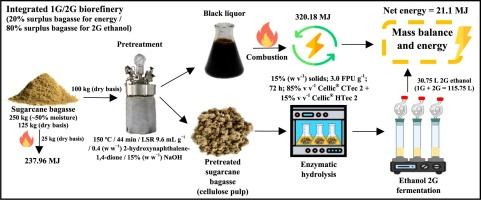Optimization of 2G ethanol production from sugarcane bagasse: Upscaling of soda pretreatment with redox mediator followed by fed-batch enzymatic hydrolysis and co-fermentation
IF 9.9
1区 工程技术
Q1 ENERGY & FUELS
引用次数: 0
Abstract
This study presents the upscaling of soda pretreatment of sugarcane bagasse (SB) using a new redox mediator (2-hydroxynaphthalene-1,4-dione) obtained from renewable resources, which does not affect enzymatic hydrolysis and fermentation. Upscaling was performed from a 0.5 L batch static stainless steel reactor to a 20 L pulp digester with forced liquor circulation, analogous to digestors used in the pulp and paper industry. Enzymatic hydrolysis of the pretreated material was optimized using the fed-batch method and was then carried out on a larger scale. The fed-batch method, combined with addition of 1 % (v v−1) Tween 80, enabled the solids load to be increased from 10 % to 15 % (w v−1), with an enzyme load of only 3.00 FPU g−1. This led to a maximum total reducing sugars concentration of ∼142 g L−1 after 72 h of hydrolysis. Co-fermentation of C5 and C6 sugar-rich hydrolysate by a consortium of CERLEV 47 (Saccharomyces cerevisiae) and CERLEV 1015 (Pichia guilliermondii) led to a maximum 2G ethanol production of 61.3 g L−1 (308 L ethanol per ton of SB). Mass and energy balances demonstrated that the combustion of black liquor, a byproduct of the soda pretreatment, could satisfy the energy demands of the pretreatment, enzymatic hydrolysis, and fermentation, with an energy of 21.11 MJ using the surplus SB (80 %) from 1G ethanol production. This finding indicated that the developed process was robust and had the potential to enhance total 2G ethanol production. This study supports the feasibility of an integrated 1G/2G biorefinery by improving energy efficiency, economic viability, and environmental sustainability.

优化甘蔗渣的 2G 乙醇生产:使用氧化还原介质进行苏打预处理,然后进行批量酶水解和联合发酵
本研究介绍了使用从可再生资源中获得的新型氧化还原介质(2-羟基萘-1,4-二酮)对甘蔗渣(SB)进行苏打预处理的升级改造,这种介质不会影响酶水解和发酵。将 0.5 升间歇式静态不锈钢反应器升级为 20 升纸浆消化器,采用强制液体循环,类似于纸浆和造纸工业中使用的消化器。预处理材料的酶水解采用喂料-分批法进行了优化,然后在更大规模上进行。喂料-分批法结合添加 1 %(体积分数-1)吐温 80,使固体负荷从 10 %(体积分数-1)增加到 15 %(体积分数-1),而酶负荷仅为 3.00 FPU g-1。水解 72 小时后,总还原糖的最高浓度达到 142 克/升。由 CERLEV 47(酿酒酵母)和 CERLEV 1015(Pichia guilliermondii)组成的联合体对富含 C5 和 C6 糖的水解物进行联合发酵,使 2G 乙醇的最大产量达到 61.3 g L-1(每吨 SB 产生 308 L 乙醇)。质量和能量平衡表明,燃烧苏打预处理的副产品黑液可满足预处理、酶水解和发酵的能量需求,利用 1G 乙醇生产中剩余的 SB(80%)可获得 21.11 兆焦耳的能量。这一结果表明,所开发的工艺是可靠的,并具有提高 2G 乙醇总产量的潜力。这项研究通过提高能源效率、经济可行性和环境可持续性,证明了 1G/2G 一体化生物精炼厂的可行性。
本文章由计算机程序翻译,如有差异,请以英文原文为准。
求助全文
约1分钟内获得全文
求助全文
来源期刊

Energy Conversion and Management
工程技术-力学
CiteScore
19.00
自引率
11.50%
发文量
1304
审稿时长
17 days
期刊介绍:
The journal Energy Conversion and Management provides a forum for publishing original contributions and comprehensive technical review articles of interdisciplinary and original research on all important energy topics.
The topics considered include energy generation, utilization, conversion, storage, transmission, conservation, management and sustainability. These topics typically involve various types of energy such as mechanical, thermal, nuclear, chemical, electromagnetic, magnetic and electric. These energy types cover all known energy resources, including renewable resources (e.g., solar, bio, hydro, wind, geothermal and ocean energy), fossil fuels and nuclear resources.
 求助内容:
求助内容: 应助结果提醒方式:
应助结果提醒方式:


